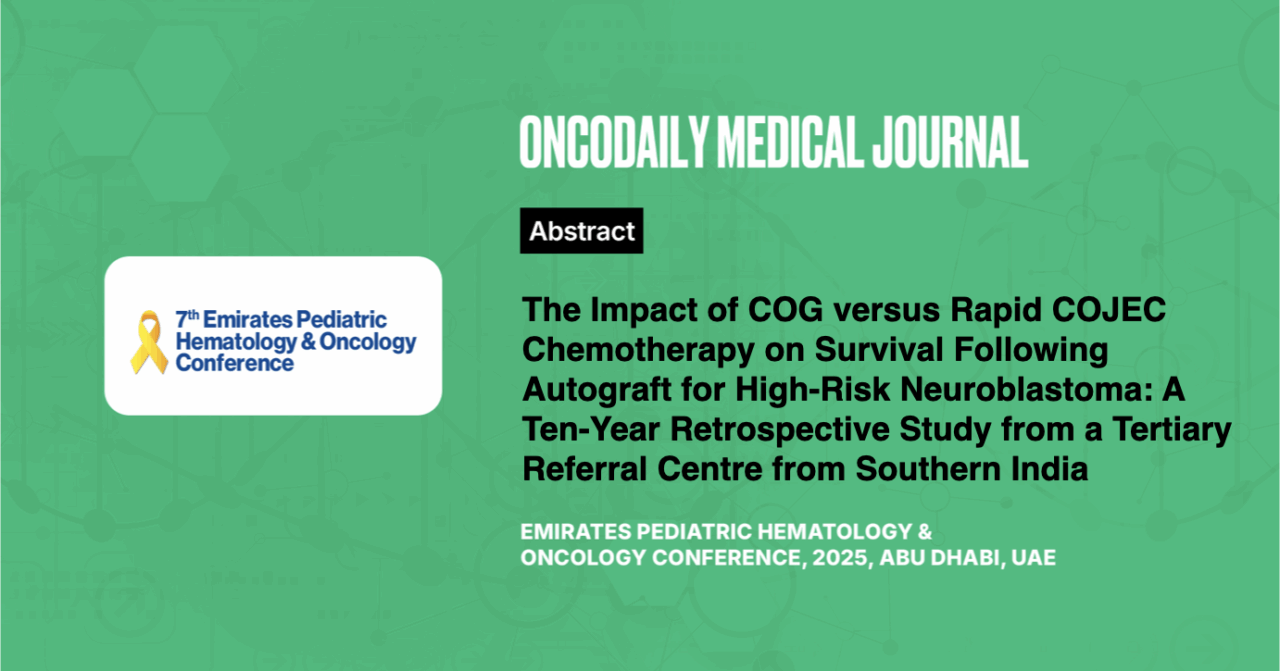The Impact of COG versus Rapid COJEC Chemotherapy on Survival Following Autograft for High-Risk Neuroblastoma: A Ten-Year Retrospective Study from a Tertiary Referral Centre from Southern India
Abstract
Introduction: High-risk neuroblastoma is traditionally known to be associated with guarded prognosis and outcome. We present our ten-year follow-up data on children with high-risk neuroblastoma and the impact of newer therapies, including haploidentical hematopoietic stem cell transplantation (HSCT) and the addition of immunotherapy. The objective is to study the outcomes of COG versus Rapid COJEC chemotherapy on survival following autograft and addition of immunotherapy for high-risk neuroblastoma.
Methodology: We performed a retrospective study and included children up to 12 years of age who underwent treatment for high-risk neuroblastoma over a period of ten years from March 2014 to March 2024 were included. We collected data from a review of patient charts on disease characteristics, including n-MYC status, first-line chemotherapy, surgical management, immunotherapy, HSCT, and outcomes.
All high-risk patients, as defined by SIOPEN or COG protocol, underwent transplantation once disease remission was achieved with first-line chemotherapy, salvage chemotherapy, and surgery. We used Busulfan and Melphalan-based conditioning for autograft and Fludarabine, Thiotepa, and Busulfan and post-transplant cyclophosphamide (PTCY for haploidentical HSCT.
Results: We included 51 patients with a male: female ratio of 1:1.3 with a median age of 1.5 years (range 6 months to 12 years). Rapid COJEC chemotherapy as per the SIOPEN protocol was used in 26 children, while 25 received high-risk COG protocol as first-line chemotherapy. Salvage chemotherapy included TVD (Topotecan, Vincristine, and Doxorubicin) in 8 children and ICE (Ifosfamide, Carboplatin, and Etoposide) in 4 children.
The majority of patients (n=46) underwent surgical excision of the primary tumour after neo-adjuvant chemotherapy, while five children had complete resolution of disease at the primary site post-chemotherapy. Autologous HSCT after high-dose chemotherapy was performed in 45 children, haploidentical HSCT in 5 children, and one child underwent autologous umbilical cord blood and peripheral blood stem cell transplantation. Only 4 patients received immunotherapy in the form of anti-GD2 therapy.
The overall survival was 15.6% in the cohort, with the survival rate being almost the same in those who received RAPID COJEC Chemotherapy or COG protocol as the first line therapy (n=5 received Rapid COJEC while n=3 received COG protocol among the 8 surviving patients). The median survival from diagnosis was 30 months, with a longer remission time of 39 months in children who received the COG protocol as first-line therapy. The remission time was poor at 21 months among those who received Rapid COJEC protocol as part of first-line chemotherapy, and this was statistically significant (P <0.05). All 4 patients who received anti-GD2 therapy and alive and doing well, with a survival rate of 100%, but the follow-up duration is less than 12 months.
Discussion: Neuroblastoma is the most frequent cancer in children less than one year old, and the most common solid tumor occurring outside of the central nervous system in all age groups.
About half of patients with neuroblastoma are classified as having high-risk disease by a combination of factors, including age at diagnosis, extent of disease, histological findings, and cytogenetic characteristics such as MYCN amplification and DNA ploidy. Historically, this group of patients had dismal outcomes, but with current multi-modal therapy, about half of the children can be expected to survive.
Therapy for children with HRNBL is actively evolving, with research driving transitions to more targeted approaches. Standard therapy includes induction with cytotoxic chemotherapy and surgical resection, consolidation with ASCT and radiotherapy, and post-consolidation anti-GD2 immunotherapy.
The goal of induction therapy is to eliminate visible disease and achieve remission. Induction therapy regimens include the COG protocol and the SIOPEN, which utilizes a rapid COJEC regimen. Trials comparing rapid COJEC to non-compressed induction therapy have shown similar outcomes, and this remains the standard induction regimen in Europe.
Incorporation of anti-GD2-based treatments into upfront therapy, during both the induction and post-consolidation setting, has shown encouraging preliminary results in clinical trials, though the impact on event-free and overall survival remains unknown. Current research efforts focus on defining the role of immunotherapy in treatment, reducing late effects, identifying novel treatment approaches, and improving the outcomes for patients with HRNBL.
Conclusion: Our study highlights the poor long-term prognosis with an overall survival of 15% in children with high-risk neuroblastoma. The children treated with the COG-based chemotherapy had a longer remission period of 39 months versus the rapid COJEC group at 21 months. Haploidentical HSCT did not offer a survival advantage. Despite the high costs involved in the use of anti-GD2 antibody, we need to consider this strategy for high-risk patients in low and middle-income countries.





